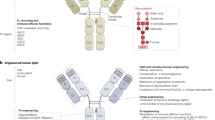Abstract
Drug dosing is commonly based on the dogma that, increasing the dose maximizes the therapeutic response until a dose level that is prohibitively toxic is reached. This doctrine also applies to antibody therapy, as several protocols have explored dose escalation. We have analyzed the effect of different amounts of a homophilic Herceptin targeting a human lung tumor cell line, and discovered that the normal dose-potency relationship does not apply. To study this paradoxical effect of antibody concentration on potency, we examined the molecular species of the homophilic Herceptin under different concentrations using size exclusion chromatography and gel electrophoresis. We also varied experimental conditions in FACS tumor targeting, such as concentration of antibody, membrane immobilization, temperature, and antibody homo/dimer immobilization. We observed that high concentrations of homophilic Herceptin reduce targeting, and also noted the tumor growth arrest in the xenograft mice after the tumor reached a critical size. The therapeutic window appears to be defined by tumor size and antibody concentration. Since the concentration of this homophilic antibody defines the optimum targeting window, our data suggest the therapeutic dose of antibody should be matched with the tumor burden.











Similar content being viewed by others
References
Adams GP, Weiner LM (2005) Monoclonal antibody therapy of cancer. Nat Biotechnol 23(9):1147–1157
Bazil V, Brandt J et al (1995) Apoptosis of human hematopoietic progenitor cells induced by crosslinking of surface CD43, the major sialoglycoprotein of leukocytes. Blood 86(2):502–511
Briles DE, Forman C et al (1982) Anti-phosphorylcholine antibodies of the T15 idiotype are optimally protective against Streptococcus pneumoniae. J Exp Med 156(4):1177–1185
Cuello M, Ettenberg SA et al (2001) Down-regulation of the erbB-2 receptor by trastuzumab (herceptin) enhances tumor necrosis factor-related apoptosis-inducing ligand-mediated apoptosis in breast and ovarian cancer cell lines that overexpress erbB-2. Cancer Res 61(12):4892–4900
Gatzemeier U, Groth G et al (2004) Randomized phase II trial of gemcitabine–cisplatin with or without trastuzumab in HER2-positive non-small-cell lung cancer. Ann Oncol 15(1):19–27
Ghetie MA, Podar EM et al (1997) Homodimerization of tumor-reactive monoclonal antibodies markedly increases their ability to induce growth arrest or apoptosis of tumor cells. Proc Natl Acad Sci USA 94(14):7509–7514
Halpern R, Kaveri SV et al (1991) Human anti-phosphorylcholine antibodies share idiotopes and are self-binding. J Clin Invest 88(2):476–482
Henson ES, Hu X et al (2006) Herceptin sensitizes ErbB2-overexpressing cells to apoptosis by reducing antiapoptotic Mcl-1 expression. Clin Cancer Res 12(3 Pt 1):845–853
Kaminski MJ, MacKenzie CR et al (1999) The role of homophilic binding in anti-tumor antibody R24 recognition of molecular surfaces. Demonstration of an intermolecular beta-sheet interaction between vh domains. J Biol Chem 274(9):5597–5604
Kang CY, Brunck TK et al (1988) Inhibition of self-binding antibodies (autobodies) by a VH-derived peptide. Science 240(4855):1034–1036
Kang CY, Kohler H (1986) A novel chimeric antibody with circular network characteristics: autobody. Ann NY Acad Sci 475:114–122
Kang CY, Kohler H (1986) Immunoglobulin with complementary paratope and idiotope. J Exp Med 163(4):787–796
Kaveri SV, Halpern R et al (1990) Self-binding antibodies (autobodies) form specific complexes in solution. J Immunol 145(8):2533–2538
Kern JA, Schwartz DA et al (1990) p185neu expression in human lung adenocarcinomas predicts shortened survival. Cancer Res 50(16):5184–5187
Kobayashi H, Shirakawa K et al (2002) Rapid accumulation and internalization of radiolabeled herceptin in an inflammatory breast cancer xenograft with vasculogenic mimicry predicted by the contrast-enhanced dynamic MRI with the macromolecular contrast agent G6-(1B4 M-Gd)(256). Cancer Res 62(3):860–866
Micke P, Hengstler JG et al (2001) c-erbB-2 expression in small-cell lung cancer is associated with poor prognosis. Int J Cancer 92(4):474–479
Russ M, Lou D et al (2005) Photo-activated affinity-site cross-linking of antibodies using tryptophan containing peptides. J Immunol Methods 304(1–2):100–106
Wehrman TS, Raab WJ et al (2006) A system for quantifying dynamic protein interactions defines a role for Herceptin in modulating ErbB2 interactions. Proc Natl Acad Sci USA 103(50):19063–19068
Wroblewski JM, Bixby DL et al (2001) Characterization of human non-small cell lung cancer (NSCLC) cell lines for expression of MHC, co-stimulatory molecules and tumor-associated antigens. Lung Cancer 33(2–3):181–194
Zhao Y, Kohler H (2002) Enhancing tumor targeting and apoptosis using noncovalent antibody homodimers. J Immunother 25(5):396–404
Zhao Y, Lou D et al (2002) Enhanced anti-B-cell tumor effects with anti-CD20 superantibody. J Immunother 25(1):57–62
Zhao Y, Russ M et al (2005) Therapeutic applications of superantibodies. Drug Discov Today 10(18):1231–1236
Zhao Y, Russ M et al (2007) Endowing self-binding feature restores the activities of a loss-of-function chimerized anti-GM2 antibody. Cancer Immunol Immunother 56(2):147–154
Acknowledgments
We wish to thank Mr. Fred Orego, Mr. Mike Russ and Benno Kohler of the Coldstream Innexus facility for performing the FACS analysis and conjugation of Herceptin. We wish to thank Genentech Inc. for the generous gift of Herceptin. Work was supported by Commonwealth of Kentucky Lung Cancer Research Program and The Lucille Parker Markey Cancer Center of University of Kentucky.
Author information
Authors and Affiliations
Corresponding author
Rights and permissions
About this article
Cite this article
Kohler, H., Bryan, A.J. Paradoxical concentration effect of a homodimerizing antibody against a human non-small cell lung cancer cell line. Cancer Immunol Immunother 58, 749–758 (2009). https://doi.org/10.1007/s00262-008-0597-z
Received:
Accepted:
Published:
Issue Date:
DOI: https://doi.org/10.1007/s00262-008-0597-z




